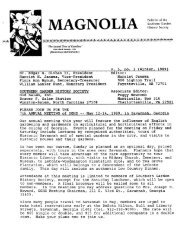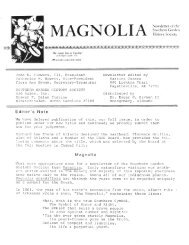Magnolia Newsletter Winter - Southern Garden History Society
Magnolia Newsletter Winter - Southern Garden History Society
Magnolia Newsletter Winter - Southern Garden History Society
You also want an ePaper? Increase the reach of your titles
YUMPU automatically turns print PDFs into web optimized ePapers that Google loves.
A Gravegarden of Old <strong>Garden</strong> Roses…<br />
(continued from page 3)<br />
trees, and the expanses of seldom cut grass punctuated by<br />
“weed-trees” and approaching engulfing kudzu.<br />
At first the goal was to clean up the fallen trees and<br />
debris, but the City of Lynchburg was not available to help<br />
because of the enormous devastation elsewhere in the city<br />
that, logically, took priority.<br />
We raised a little money, about $5,000 from the Keep<br />
Lynchburg Beautiful Commission, its Forestry Advisory<br />
Committee, and some from Hillside <strong>Garden</strong> Club. In my<br />
earlier life as a Landscape Designer and restorer of abandoned<br />
gardens, I felt I knew what to do—this was just on a scale 26<br />
times larger than I had ever dealt with before.<br />
Luckily a “yard man” from my past, Frank Coles, lived in<br />
a very humble dwelling back to back with the cemetery<br />
boundary near the train tracks. Frank had helped me at my<br />
home in recent years with gardening projects. He needed the<br />
money. So did Jimmy Preston, a younger man with a family<br />
who lived in the cemetery neighborhood.<br />
The three of us began the cleanup with power saws, axes,<br />
clippers, rakes, shovels, and gloves. Forsaking all other<br />
projects, we worked daily for about a year. Occasionally the<br />
city would send through a chipper to grind up what we had<br />
dragged over to the side of the road.<br />
The story of the cemetery, its restoration—reclaiming—<br />
rehabilitation—has so many directions from this point. Each<br />
is an entire chapter in itself—each is an important story to be<br />
told.<br />
But back to the roses, for they are the symbol, the<br />
common thread of love and beauty and persistence—thorns,<br />
problems, blooms, bursts of energy, cycles of progress, some<br />
losses, some gains, some victories. Through it all, they have<br />
been there.<br />
Throughout the rest of the cemetery, four roses had been<br />
discovered earlier: a ‘La Marne’ in the Confederate Section<br />
hedge, a Katharina Zeimet on the gravemarker of Cora Belle<br />
Gilliam, ‘Shailer’s Provence’ on the iron fence around the<br />
Harrison-Norvell family plot, and the Banshee on the grave of<br />
the great-niece of George Washington: survivors all.<br />
A lovely story concerns the Banshee rose. We had cut the<br />
Banshee, entangled in much honeysuckle and privet, to the<br />
ground in the innocent effort to uncover a small iron fence<br />
enclosure. The surprise revelation was the false crypt of Maria<br />
Ball Carter Tucker and her daughter Rosalie, and the<br />
(Before) The Tucker plot was<br />
engulfed in jungle growth.<br />
(After) After clearing, Banshee rose<br />
re-blooms again 150 years later.<br />
inscription on the crypt which read, “the rose and rosebud<br />
scarce half blown…” The Banshee rose, we surmised, had<br />
been planted on the grave by the surviving family.<br />
Miraculously this living symbol of the mother, the “rose,” and<br />
14-year-old daughter “rosebud scarce half blown”, revived and<br />
lived and blooms beautifully even today.<br />
Fallen gravemarkers were set upright again and, though<br />
no longer legible, many did have some carving intact. A rose<br />
was a common adornment, sometimes “full bloom,”<br />
sometimes drooping its head, a symbol of death. Noticing<br />
these symbols on the gravemarkers was my first exposure to<br />
the beautiful subtleties evident throughout this, or any, old<br />
graveyard. There was so much I didn’t know. I didn’t begin to<br />
know how much I needed to know to reclaim this graveyard.<br />
All I really had going for me was persistence and<br />
determination…and the fact that there was so much to be<br />
done that it took time. Time was what was needed for me to<br />
learn and begin to open my eyes to the bigger picture—the<br />
amazing history of the sacred place, and to gather more and<br />
more volunteer helpers and private funds.<br />
By now, time had taken its toll on Carl Cato. He had had<br />
to put his beloved wife in a nursing home where he took care<br />
of her daily for years. Then he<br />
himself required care. We talked<br />
many times before and during this<br />
difficult period. I knew my rose<br />
mentor was leaving, and he did, too.<br />
In preparing for the move into the<br />
nursing care facility, he gave his<br />
precious roses, the plants themselves,<br />
to me and two other rose friends,<br />
Shirley Lynde and Julie Sackett. We<br />
transferred them to our own gardens.<br />
He went through his rose library and<br />
Carl Cato (left) and Henry<br />
Mitchell enjoyed a first-time<br />
meeting before the <strong>Garden</strong><br />
Club of Virginia Horticulture<br />
Field Day in Lynchburg.<br />
gave me the entire collection of books, papers and early issues<br />
of the Heritage Roses <strong>Newsletter</strong>. 2<br />
I remember my utter sense of panic at my inability to<br />
remember all the principles and techniques of pruning of the<br />
various classes of old roses. Each spring I had prevailed on Mr.<br />
Cato to come to the Old Brick Wall Roses and help me train<br />
and prune them. We did this for at least three years, but each<br />
year seemed to present the same questions…there was so<br />
much to learn and he was fading away.<br />
One wonderful occasion helped with the closure that was<br />
inevitably approaching. In October 1996, the Horticulture<br />
Committee of the <strong>Garden</strong> Club of Virginia hosted an Annual<br />
Horticulture Field Day in Lynchburg with the roses along the<br />
Old Brick Wall being the actual hosts. Special guests for the<br />
occasion were <strong>Garden</strong> Club members from across the state,<br />
Carl Cato, and our keynote speaker, Washington Post<br />
columnist and garden writer, Henry Mitchell. It provided a<br />
poignant first time meeting for these two men who had<br />
known and admired each other through the years.<br />
(continued on page 5)<br />
4 <strong>Magnolia</strong> • Spring-Summer 2005 Vol. XX, No. 1
















